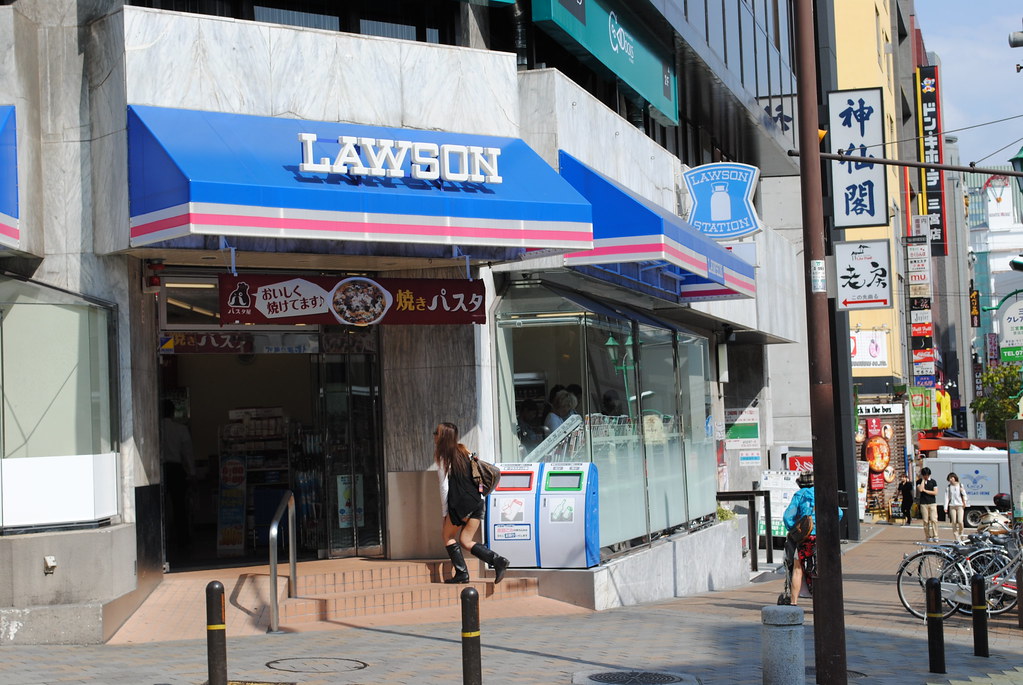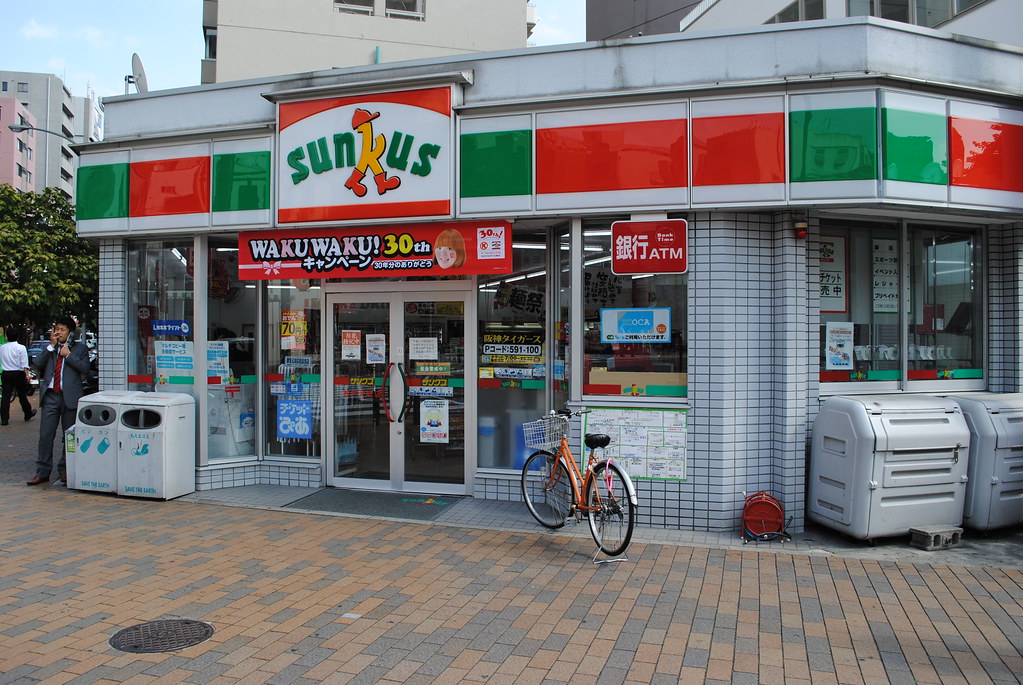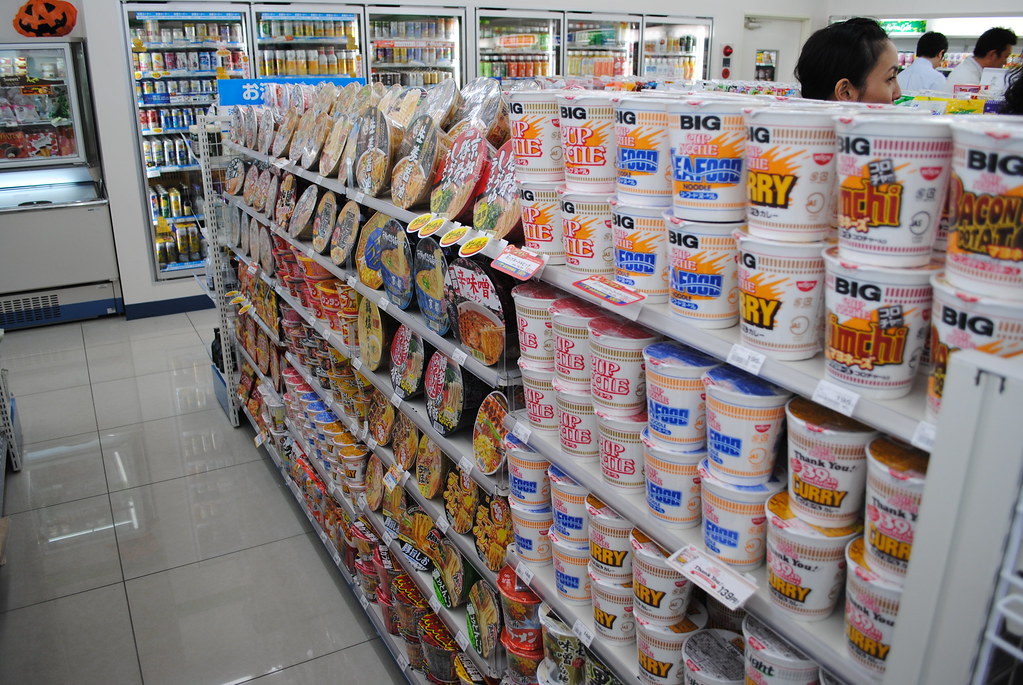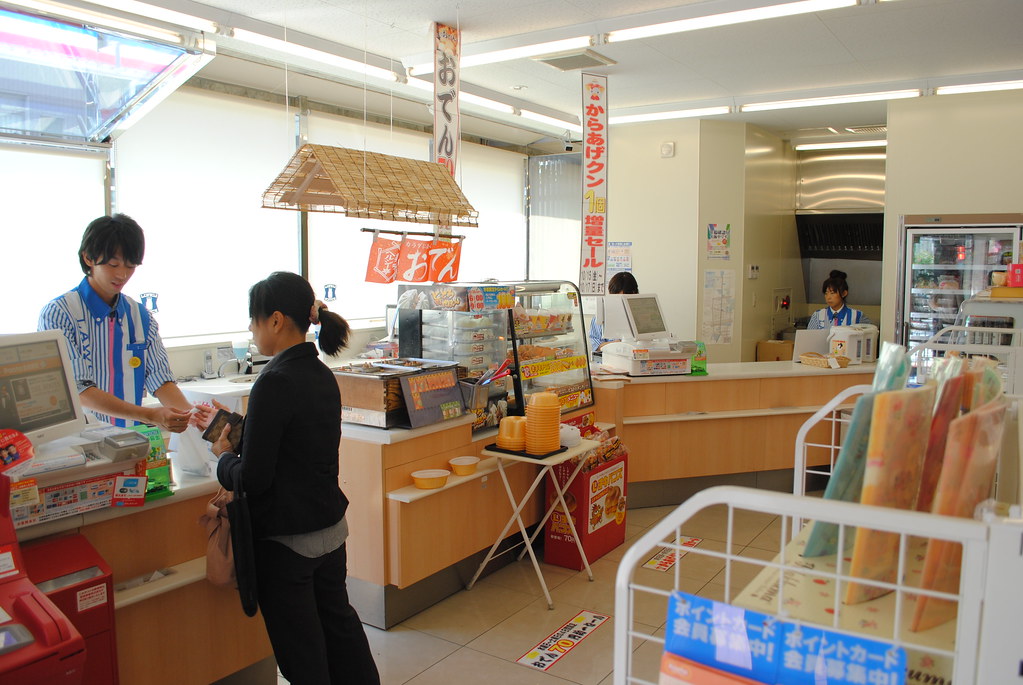The most common コンビニ in Japan are the instantly recognisable green, red and orange 7-11 (now known less catchily as “7 and i Holdings”)...
...the blue, pink and white Lawson...
and the green, blue and white Family Mart. In fact, pick any street and walk for five minutes and I would be very surprised if you didn't see at least one.
Others such as Mini Stop, Asnas, Sunkus, Daily Yamazaki, AMPM and Circle K also pop up regularly as well as a multitude of smaller local コンビニ and rest stops. In all cases, they are open 24 hours a day 7 days a week, particularly filling the gaps when the banks, restaurants and supermarkets close their doors. Interestingly they don’t seem to be as expensive as 24 hour delis and service stations at home; I imagine that competition as well as the buying power of each franchise helps to keep their prices down. The other factor is the sheer amount of business they seem to get at all hours – コンビニ are often seen as the first stop for people looking to pick up a few things, rather than a place you’re forced to go when everything else is shut.
Like their Western equivalents, コンビニ feature a huge variety of snack food, drinks and meals. Beyond the usual selection of カップラーメン (cup ramen) and おにぎり (onigiri - rice balls), the food that's there depends slightly on the season. 夏 (なつ - natsu - Summer), for example offers up a wide range of サラダ (sarada - salad), サンド (sando - sandwiches), cold noodles and cool drinks.
At colder times of the year heated cases pop up on the counters, offering hot coffee (in a can!), 肉まん (にくまん - nikuman - steamed chinese buns) and selections of 串焼き (くしやき - grilled skewers). Even the 弁当 (べんとう - bentou - lunchboxes) found in the fridges are seasonal - new stuff is delivered regularly to match the weather, coming events and festivals, whether that means stodgy Winter food or lighter Summer fare.
It's not all about food, of course - as you'd expect, コンビニ offer a huge range of handy things that you might have missed at the supermarket, from toothbrushes to bike pumps. A lot of these kinds of things are seasonal as well - when it's getting around time for 花見 (はなみ - hanami - cherry blossom viewing), you'll notice special stands with all your picnicking needs like tarpaulins, plastic cups and snacks taken care of; Summer heralds extensive displays of 花火 (はなび - hanabi - fireworks) that you can buy on the way to the beach or park. The shops are always decorated subtly to suit the current season or event too; if you look carefully in today's photos, you might notice the odd Halloween jack-o'-lantern or red Autumn leaf.
Almost without exception, a コンビニ will have an inexhaustable rack of 漫画 (まんが - manga) and magazines which will traditionally be surrounded by people reading away; some shops seem to be tying their books shut now to stop people treating them like a library. That doesn't stop people from using their コンビニ as a hangout though - they make a popular landmark to meet up with friends and it's not uncommon to see people sitting outside one for hours on end.
What makes コンビニ really unique though is the other services they offer. Utility, internet and phone bills can all be taken there to be paid in cash through what's called a 払い込み (はらいこみ - haraikomi - payment) service. They sell 切手 (きって - kitte - stamps) and offer a 配達 (はいたつ - haitatsu - delivery) service that can be used to post or courier packages anywhere in the country. They even offer チケット購入 (ちけっとこうにゅう - chiketto kounyuu - ticket purchase) services that allow you to buy tickets to concerts, festivals, theme parks and sports games through a machine; in some cases this is the only way you can get them! Finally, they have 引き出し (ひきだし - hikidashi - withdrawal) and 預け入れ (あずけいれ - azukeire - deposit) ATM services, which are particularly useful because most bank ATMs close late in the evening for some reason.
After spending a bit of time here and having コンビニ solve all your problems for the umpteenth time, it's easy to see their appeal - they really live up to their name. Whether they're used for a late night お酒 (おさけ - osake - alcohol) or タバコ (tabako - cigarettes) run, a daily coffee and 弁当 ritual or your ticket to the 野球 (やきゅう - yakyuu - baseball) grand final, it's hard to deny that コンビニ are an indespensible part of the Japanese machine. Give one a try if you're around and before long you'll wonder how you ever did without. Oh, and grab me some milk while you're there.
...the blue, pink and white Lawson...
and the green, blue and white Family Mart. In fact, pick any street and walk for five minutes and I would be very surprised if you didn't see at least one.
Others such as Mini Stop, Asnas, Sunkus, Daily Yamazaki, AMPM and Circle K also pop up regularly as well as a multitude of smaller local コンビニ and rest stops. In all cases, they are open 24 hours a day 7 days a week, particularly filling the gaps when the banks, restaurants and supermarkets close their doors. Interestingly they don’t seem to be as expensive as 24 hour delis and service stations at home; I imagine that competition as well as the buying power of each franchise helps to keep their prices down. The other factor is the sheer amount of business they seem to get at all hours – コンビニ are often seen as the first stop for people looking to pick up a few things, rather than a place you’re forced to go when everything else is shut.
Like their Western equivalents, コンビニ feature a huge variety of snack food, drinks and meals. Beyond the usual selection of カップラーメン (cup ramen) and おにぎり (onigiri - rice balls), the food that's there depends slightly on the season. 夏 (なつ - natsu - Summer), for example offers up a wide range of サラダ (sarada - salad), サンド (sando - sandwiches), cold noodles and cool drinks.
At colder times of the year heated cases pop up on the counters, offering hot coffee (in a can!), 肉まん (にくまん - nikuman - steamed chinese buns) and selections of 串焼き (くしやき - grilled skewers). Even the 弁当 (べんとう - bentou - lunchboxes) found in the fridges are seasonal - new stuff is delivered regularly to match the weather, coming events and festivals, whether that means stodgy Winter food or lighter Summer fare.
It's not all about food, of course - as you'd expect, コンビニ offer a huge range of handy things that you might have missed at the supermarket, from toothbrushes to bike pumps. A lot of these kinds of things are seasonal as well - when it's getting around time for 花見 (はなみ - hanami - cherry blossom viewing), you'll notice special stands with all your picnicking needs like tarpaulins, plastic cups and snacks taken care of; Summer heralds extensive displays of 花火 (はなび - hanabi - fireworks) that you can buy on the way to the beach or park. The shops are always decorated subtly to suit the current season or event too; if you look carefully in today's photos, you might notice the odd Halloween jack-o'-lantern or red Autumn leaf.
Almost without exception, a コンビニ will have an inexhaustable rack of 漫画 (まんが - manga) and magazines which will traditionally be surrounded by people reading away; some shops seem to be tying their books shut now to stop people treating them like a library. That doesn't stop people from using their コンビニ as a hangout though - they make a popular landmark to meet up with friends and it's not uncommon to see people sitting outside one for hours on end.
What makes コンビニ really unique though is the other services they offer. Utility, internet and phone bills can all be taken there to be paid in cash through what's called a 払い込み (はらいこみ - haraikomi - payment) service. They sell 切手 (きって - kitte - stamps) and offer a 配達 (はいたつ - haitatsu - delivery) service that can be used to post or courier packages anywhere in the country. They even offer チケット購入 (ちけっとこうにゅう - chiketto kounyuu - ticket purchase) services that allow you to buy tickets to concerts, festivals, theme parks and sports games through a machine; in some cases this is the only way you can get them! Finally, they have 引き出し (ひきだし - hikidashi - withdrawal) and 預け入れ (あずけいれ - azukeire - deposit) ATM services, which are particularly useful because most bank ATMs close late in the evening for some reason.
After spending a bit of time here and having コンビニ solve all your problems for the umpteenth time, it's easy to see their appeal - they really live up to their name. Whether they're used for a late night お酒 (おさけ - osake - alcohol) or タバコ (tabako - cigarettes) run, a daily coffee and 弁当 ritual or your ticket to the 野球 (やきゅう - yakyuu - baseball) grand final, it's hard to deny that コンビニ are an indespensible part of the Japanese machine. Give one a try if you're around and before long you'll wonder how you ever did without. Oh, and grab me some milk while you're there.







No comments:
Post a Comment
If you have any questions or additions, I would love to hear from you. I may not know the answer, but I'll do my best to find out in any case! You can post anonymously if you like, but abusive/unintelligible/inappropriate comments will not be published.